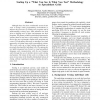4856 search results - page 10 / 972 » What Values in Design |
VL
1999
IEEE
13 years 11 months ago
1999
IEEE
Although there has been considerable research into ways to design visual programming environments to improve the processes of creating new programs and of understanding existing o...
Publication
While objects of our focus of attention (“where we are looking at”) and accompanying affective responses to those objects is part of our daily experience, little research exis...
EMNLP
2008
13 years 8 months ago
2008
This paper describes a language-independent, scalable system for both challenges of crossdocument co-reference: name variation and entity disambiguation. We provide system results...
TSE
2002
13 years 7 months ago
2002
Although there has been recent research into ways to design environments that enable end users to create their own programs, little attention has been given to helping these end u...
ECAI
1998
Springer
13 years 11 months ago
1998
Springer
Many kinds of knowledge-based system would be easier to develop and maintain if domain experts (as opposed to knowledge engineers) were in a position to define and edit the knowled...

